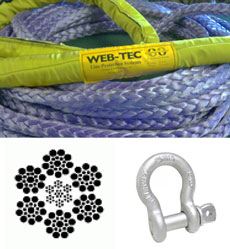The basic building blocks of a wire rope are its wires. The classification of these wires indicates their features. Characteristics like abrasion and fatigue resistance are directly affected by the construction of the wire strands. In strands that have two or more layers of wires, the job of the inner layer is to support the outer layers in such a way that all wires can still adjust and slide freely when a rope bends.
As a rule of thumb, strand ropes are made up of a few large wires that make the overall rope more abrasion resistant. It will also suffer less fatigue resistance when compared to the same sized rope built with smaller wires. Below, we want to highlight the basics of wire rope and verope strand constructions.
- Combined Patter Strand: this refers to strands formed in a single operation, but two of more construction types are used. For instance, the first layer can utilize one construction, and the other layers have a different construction.
- Filler Wire Strand: this rope construction has two uniformly sized layers wrapped around a center. The inner layer has half the number of wires when compared to the outer layer. Smaller, filler wires are equal in number to the inner layer, and they are laid within the valleys of the inner layer.
- Seale Strand: the construction type uses two layers wrapped around a center with equal numbers of wire in each layer. All wires have the same diameter. Lastly, the design has a large outer wire that rests within the valleys of smaller inner wires.
Wire Rope